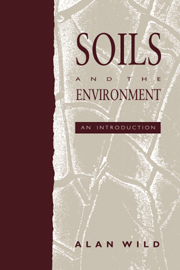Book contents
- Frontmatter
- Contents
- Preface
- Acknowledgements
- Units, symbols and general information
- 1 Introduction: soil in a natural and man-made environment
- A Soil properties and processes
- B Soils in relation to the environment
- 7 Soil as a medium for plant growth
- 8 Soil conditions and crop production
- 9 Soil acidification
- 10 Heavy metals and radionuclides in soil
- 11 Soils, the atmosphere, global warming and ozone depletion
- 12 Soil erosion and conservation
- 13 Soils in the environment: problems and solutions
- Suggestions for further reading
- Index
10 - Heavy metals and radionuclides in soil
Published online by Cambridge University Press: 06 January 2010
- Frontmatter
- Contents
- Preface
- Acknowledgements
- Units, symbols and general information
- 1 Introduction: soil in a natural and man-made environment
- A Soil properties and processes
- B Soils in relation to the environment
- 7 Soil as a medium for plant growth
- 8 Soil conditions and crop production
- 9 Soil acidification
- 10 Heavy metals and radionuclides in soil
- 11 Soils, the atmosphere, global warming and ozone depletion
- 12 Soil erosion and conservation
- 13 Soils in the environment: problems and solutions
- Suggestions for further reading
- Index
Summary
Introduction
There are two parts to this chapter. Sections 10.2–10.6 deal with elements generally associated with industrial and urban pollution, most of which are metals that are often described as heavy metals (see Section 10.2). Sections 10.7–10.9 are more specific and describe some of the environmental problems caused by radionuclides (also called radioactive nuclides or radioactive isotopes which decay with time, in contrast to stable isotopes).
Heavy metals are natural components of the environment, but are of concern because they are being added to soil, water and air in increasing amounts. Some, for example copper, manganese and zinc, are micronutrients (trace elements) which are essential in small amounts for plant and animal life (Section 7.5). They can, however, be harmful if they are taken up by plants or animals in large amounts, as can other heavy metals not known to be essential nutrients. The objective of research is to establish the amounts, or concentrations, that are safe. It should be noted that advances in instrumentation have made possible the measurement of concentrations which were previously not detectable, but it does not follow that these low concentrations necessarily indicate any hazard to health.
Radionuclides are a danger, rarely from the elements themselves but from the radiation they emit (plutonium is an exception, being highly toxic to animals). Some occur naturally, exposing all living organisms to small and usually harmless doses of radiation. Particularly dangerous are some man-made radionuclides that accumulate as they pass through a biological cycle. For example, the chemistry of strontium is similar to that of calcium, and radionuclides of strontium accumulate with calcium in bone tissue, where they emit radiation.
- Type
- Chapter
- Information
- Soils and the Environment , pp. 189 - 210Publisher: Cambridge University PressPrint publication year: 1993
- 1
- Cited by



